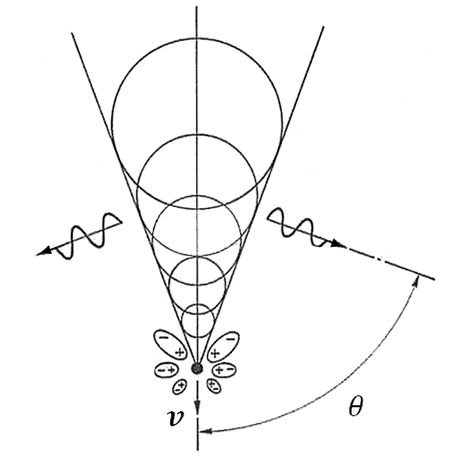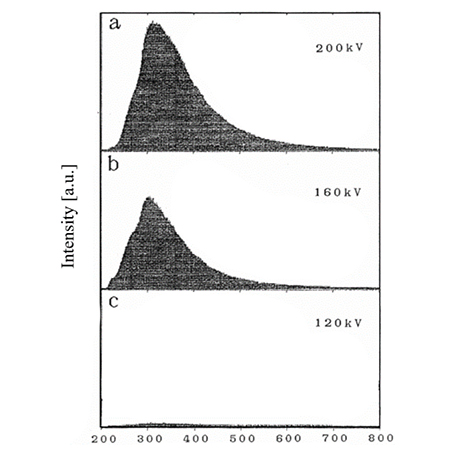チェレンコフ放射
チェレンコフ放射
Cherenkov radiation
[目次:理論(電子の散乱/回折/結像)]
物質(媒質)内を運動する荷電粒子が、その媒質中における光速(c/n, cは真空中の光速, nは媒質の屈折率)を超えるとき、媒質から光が放射される。これをチェレンコフ放射という。
図1に示すように、媒質中に入った荷電粒子のまわりには電気分極が発生し、粒子が通過した後にその電気分極が消滅する過程で光が放射される。粒子の軌跡に沿った各点から放射される光は、粒子の速度が媒質中の光の速度より速い場合、図1に示すように特定の方向に波面がそろい鋭い指向性を持つ光が放射(チェレンコフ放射)される。この現象は、超音速の飛行物体が衝撃波を発生する機構と類似している。荷電粒子の速度が媒質中の光の速度より遅い場合には光の位相がそろわず減衰してしまい、チェレンコフ放射の現象は起きない。
電子の入射により発生するチェレンコフ光は次の性質をもつ。ここで、nは媒質の屈折率、vは電子の速度、cは真空中の光速を表わし、β=v/cである。
- チェレンコフ放射の発生条件は v>c/n または nβ>1 で与えられる。(臨界速度)
- 放射角 θ は cosθ=1/nβ で決まる。
- 放射スペクトル強度I(λ)はλ-2の依存性を示す。
加速電圧が100kV (200kV) で加速した電子の速度は、光速の0.55倍(0.70倍)になる。媒質の屈折率が 1.8 (1.4) より大きな場合、その電子の速度が媒質中の光速を超えるため、チェレンコフ放射を発生する。図2に、異なる加速電圧で加速した電子をマイカ薄膜に入射したとき、電子顕微鏡で観測されたチェレンコフ放射スペクトルを示す。マイカの屈折率は1.59なので臨界速度を与える加速電圧は146kVである。加速電圧が120kVでは放射は観測されず、160kVおよび200kVでは強い放射が起こっていることが分かる。
なお、チェレンコフ放射を用いた計数装置は、高エネルギー物理学の分野の測定器としてニュートリノ等の検出に用いられている。
(東工大 山本直紀博士 執筆)
チェレンコフ放射の発生機構 ⇒ 図1
マイカ薄膜からのチェレンコフ放射スペクトル。加速電圧は(a)200 kV、(b)160 kV、および(c)120 kV。 ⇒ 図2
When a charged particle running in a material (medium) exceeds the velocity of light in the medium(c/n, c is the velocity of light in vacuum, and n is the refractive index of the medium), light is emitted from the medium. This is called Cherenkov radiation.
As shown in Fig. 1, electric polarization arises around the charged particle that enters the medium, and light is created when the electric polarization disappears after the particle passes. The light from each point along the particle trajectory forms a uniform wave-front in a specific direction and a light with a sharp directivity (Cherenkov radiation) is emitted when the particle runs faster than the velocity of light in the medium. This phenomenon is similar to the shock wave generated by a supersonic flying object. When the velocity of the charged particle is slower than the velocity of light in the medium, the phases of the light are not matched in any direction and Cherenkov radiation is not generated.
Cherenkov radiation generated by electron incidence has the following properties. Here, n is the refractive index of the medium, v the velocity of electron, c the velocity of light in vacuum, and β=v/c.
- The condition for the generation of Cherenkov radiation is given by v>c/n or nβ>1. (Critical velocity)
- The radiation angle θ is determined by cosθ=1/nβ.
- The spectral intensity of the radiation I(λ) shows the dependence of λ-2.
For electrons accelerated at an accelerating voltage of 100 kV (200 kV), β=0.55 (β=0.70), Cherenkov radiation is generated when the refractive index of the medium is larger than 1.8 (1.4).
Fig. 2 shows the Cherenkov radiation spectra from a mica thin film observed in an electron microscope for different accelerating voltages of the incident electrons. Since the refractive index of mica is 1.59, the acceleration voltage that gives the critical velocity is 146 kV. It is seen that radiation is not observed at an accelerating voltage of 120 kV, but that strong radiation appears at 160 kV and 200 kV.
It is noted that a counting device using Cherenkov radiation is used for detecting neutrinos and other elementary particles in the field of high energy physics.
(By Dr. Naoki Yamamoto, Tokyo Institute of Technology)

Fig. 1
Generation mechanism of Cherenkov radiation.

Fig. 2
Cherenkov radiation spectra from a mica thin film at different accelerating voltages, (a) 200 kV, (b) 160 kV, and (c) 120 kV.
関連用語から探す
説明に「チェレンコフ放射」が含まれている用語






